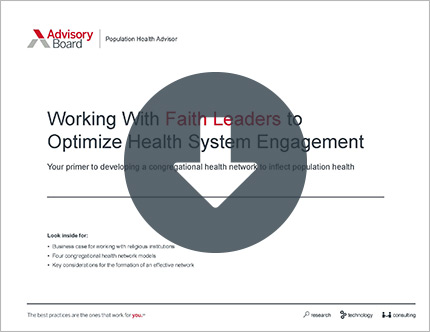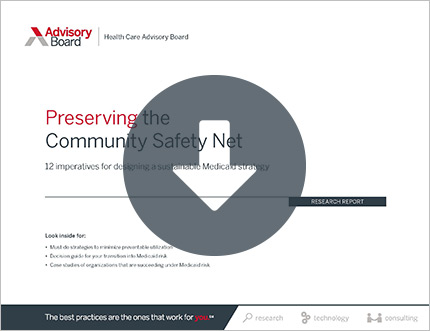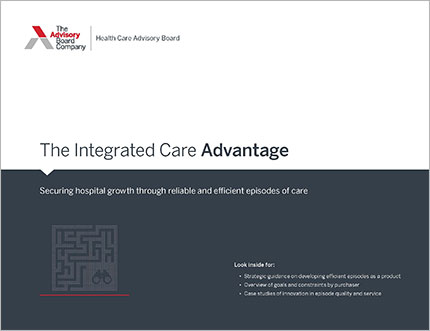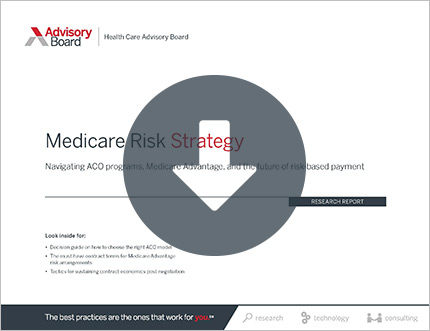Welcome to the "Lessons from the C-suite" series, featuring Managing Partner Eric Larsen's conversations with the most influential leaders in health care.
In this edition, Terry Shaw, CEO of Adventist Health System, talks to Eric and Brad Rose, managing principal, about Adventist's approach to spiritual care, why he thinks about growth "like a farmer," and how he plans to turn AHS into a $20 billion system.
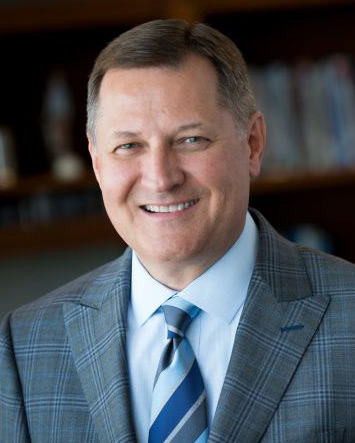
Terry Shaw, president and CEO, Adventist Health System
Question: Terry, let's start with something that makes you quite distinct among your peers: You've been at Adventist Health System for going on 35 years—
Terry Shaw: —It's hard to believe, isn't it?
Q: It's outstanding. I can think of a couple of other examples, like Peter Fine's nearly 20 years at Banner Health, but there aren't too many tenures like yours. So take me back to when you started as a business intern in 1982. I've heard you call how you ended up at Adventist a "God moment."
Shaw: It was absolutely a God moment. I was merely working my way through college. Back then, Adventist Health System (AHS) would get a single finance intern. It just so happened that the No. 1 guy in our class was not available, and since I was No. 2, my professor asked if I wanted to go instead. I was like, "Where? Who's that?" He told me, "It's in Orlando. You get to go to the beach." I was like, "Yeah, I'm in."
So I went down and interviewed, got the job for the summer. It was fantastic. And the next summer, I went back and worked, and then I graduated and they gave me a job offer. People ask me, "How did you pick health care?" and I tell them, "Health care picked me."
Q: So here you are, remarkably enough, 35 years later. Walk me through the journey from lowly intern to system CEO.
Shaw: I never knew where I would end up. But one thing I picked up along the way was that if you're willing to work hard and solve people's problems, others will bring you their problems to solve—and if you solve enough of other people's problems, they don't have any choice but to promote you.
That's just kind of the way my career has been. When our CFO left, I had been in operations at our flagship facility, Florida Hospital, and I was really happy. I had spent four years with scrubs on—no suit. The team would spend time in the OR, watch surgeries and schedule and transport patients. And then we would take all the doctors and nurses that we worked with and we would pull the OR apart and put it back together to make it function better.
At one point, our CFO went to do something else, and I was the only guy on the 11th floor with a CPA certificate, and my boss tells me that he wants me to be CFO. Considering that I was 32 at the time, I said, "Yeah, right." And he goes, "No, I'm serious. I'm going to go get a cup of coffee. Think about it." So about eight minutes later, I was CFO. Some years later, I was in the corporate office, and I was named COO as well. Truly, the whole career path was not something I could have drawn up—it just happened.
Q: But you said there was 'the moment'—a kind of epiphany, if you will, that confirmed you on your path. What was it?
Shaw: Yes, that's true. I was a young assistant vice president at Florida Hospital, and the executive team was talking extensively about our spiritual care plans in our market for the next year at a planning retreat. And it suddenly dawned on me that this place was just as serious about spiritual care as they were about everything else: clinical care, financial results, the whole nine yards. And it just was an "aha" moment for me. I was all in.
Spiritual care
Q: Let's talk about that passion, that authenticity about caring for the "whole person" that animates what you're describing. Perhaps you could elaborate on how Adventist approaches spiritual care. I understand you've deployed 110 chaplains across the system—all rigorously trained and certified—that are on the 'front lines' of this work.
Shaw: Yes, absolutely. Through the studies that Ted Hamilton, our Chief Mission Officer, has done with Dr. Koenig at Duke University, we've determined that not only will doctors and their staff embrace spiritual care themselves, but their patients of all faiths many times need spiritual resources that they don't get, whether that's through prayer, support groups, or other means.
For 2018 and 2019, we're trying to do a better job of making spiritual care resources available in the outpatient setting, where 92% of our patient contacts take place.
Within the four walls of your hospital, having a chaplain see a person and talk to his or her family is easy. In the outpatient setting, you're faced with all kinds of things—homelessness, food insecurity, family members' health conditions. There are all kinds of things that you're all of a sudden confronted with that impact the spiritual health of the patient.
We can't do this alone. We can organize it. We can set it up. But we need to involve people of all faith traditions in this process. We need to partner with community resources, such as Coalition for The Homeless and Second Harvest Food Bank. You can't look at it as something you're solving for yourself, you have to look at it as something you're helping the community with.
Hurricanes Harvey and Irma
Q: I would expect that this multi-dimensional care—clinical, social determinants, spiritual, etc.—is a major element of how you're thinking about the recovery in Florida from Hurricanes Harvey and Irma.
Shaw: Absolutely it is. Unfortunately, one of the real consequences post-natural disaster is the uptick in mental health issues. As you drive your car through "seas of light" and then you get to your section of town that is a black spot in a sea of light, you experience a psychological wearing that you really can't describe. Whether you're rich, poor, middle class, it's the same issue. Spiritual care is a huge dimension of how we're thinking about recovery.
Q: Looking back, 2017 was certainly an unprecedented year for natural disasters—all over the United States. You and so many of your fellow CEOs had to ready your organizations for the unthinkable. Can you talk about how you prepared for and responded to Harvey and Irma?
Shaw: You do not want to be the entity that's supposed to care for your community and can't do its job. If you get hit by a really bad disaster and you're destroyed, that's one thing. But you're expected to have basic services up and running. We delivered 50 babies each day during the hurricane. We had multiple heart surgeries, multiple brain surgeries. When I say we had all hands on deck, I mean it—we were ready to go.
At Florida Hospital, for instance, before the power went out, we actually paid to have six semi-trailers that are nothing but one generator apiece, come to Central Florida and just sit. And we ended up using three of them. It was a good thing we did because power was out in Hardee County. Bless the power workers that drove their trucks to our state, some from as far away as California, just to work on power issues. Ahead of one of the storms, we had to take patients out of our hospitals on one coast as a precaution, and then out of our hospitals on the other coast when it changed course.
Q: The devastation from the storms, the aftermath, will be felt for years. I've talked to your peers over the years about how they've responded to these natural disasters in the moment—Lynn Britton, CEO of Mercy, as an example, rushing right to the devastated area to help rally his staff after their hospital in Joplin, Missouri, was completely wiped off the map by a tornado. I suppose, as much as you can prepare, sometimes you just have to respond in the moment.
Shaw: You're exactly right, Eric. You rise to the moment. You figure it out. It's not just clinicians doing medical work; all your business people come in to do all the other stuff. Everybody's on deck.
On the business side, everyone has to handle a range of tasks that aren't part of their typical jobs—from parking cars to running the day care. I remember when I was in my mid-20s working at the hospital during a hurricane and they told me, "You work in rev cycle and finance? Guess what? For the next 72 hours, you're taking care of 300 kids."I looked at them and said, "You're kidding me, right?" and they said, "Bring three days of food and water. Bring your own toiletries. And your full-time job is taking care of kids."
And at the same time, during a hurricane, everybody goes to the hospital. It's supposed to be an environment where everybody is going to take care of you. Homeless people come to your ED instead of a shelter. And you don't have time to take them to a shelter, so you give them a blanket and you find a spot for them to be for the next three days.
Q: That brings us back to something you were talking about earlier, about how this 'whole person care' requires us to really get underneath some of the social determinants of health. Today, there's significant energy and attention on social determinants—and yet arguably this has been the ministry for the Seventh-day Adventist Church for 150 years. What's it like for you to see the health care ecosystem as a whole shifting its focus toward this?
Shaw: It's a great affirmation to see this nationally, and you're right—this is basically getting back to our roots. The tenets of the sanitarium model—good food, exercise, hygiene, light, fresh air, belief in a higher power—are as applicable today as they were in the 1800s.
When you take a look at having spiritual care in the outpatient setting, getting community resources around a population of people, figuring out how to bring better health to people, it does work its way into medical loss ratios (MLRs), but the truth is we're trying to run our strategies no matter what the payment scheme is.
One thing that's clear is that for the foreseeable future, we're going to get paid less and less to do whatever it is we're doing.
Care management and declining reimbursement
Q: That structural challenge you've just articulated—reimbursement heading relentlessly south at the same time our fixed costs remain unsustainably high—is something every health system CEO is grappling with. Can you expand a bit on how Adventist is addressing this?
Shaw: We're modifying ways to deliver care and do it in a way that will produce the right outcome for the patient in the most appropriate setting. Take chest pain: We took 3,000 admissions out of Florida Hospital in the first eight months of 2017. We had to rethink how the ED team and our hospital medicine teams look at the diagnosis.
When that patient walks in the door, the easiest thing to say is, "You're being admitted to the hospital." The hard thing to do is to line up community resources, either yours or somebody else's, to care for the patient. Now, it's better for the patient because it's going to cost him or her less money, but it's harder for our infrastructure because we are modifying many of our practices.
Between our customer relationship management web strategy, call center strategy, and patient navigation strategy, we want patients to start interfacing with somebody from a brand perspective that knows you and owns that care management. We want to go from "we'll care for you if you're bad enough to show up" to "we're going to care for you no matter where you are in your health journey."
So our big mantra is "we don't discharge patients from our care." There are only two industries that discharge people: health care and the military. I'd like health care to be taken out of that paradigm. If we don't make these changes now, down the road, we're going to be too expensive. At the end of the day, you have to reinvent yourself.
Q: Let's make this real by examining your largest market, Orlando—one of the most competitive markets in the country. Your Florida Hospital has a 50% market share; a competitor has 30%. Lots of health care construction—currently a billion dollars of projects in flight. Talk about some of the dynamics here.
Shaw: Yes, Orlando is transforming. Fast. It is in the process of moving from a cottage industry to a care delivery system that has the components of care navigation, a connected outpatient system overlay, management of lives, and so forth. That's the fundamental change that Orlando is going through.
From my perspective, the mindset that's going to have to change is in the care delivery, navigation process and who drives it every day. What we've lost in health care is that when the patient is really sick, there's nobody who captains their care. When you come to the hospital, you have three hospitalists see you. We've got to solve that problem.
Q: So you've decided to vertically integrate and offer a provider-sponsored health plan in Orlando, white labeling a Medicare Advantage plan with Health First. How has the experience been so far? What is enrollment looking like?
Shaw: We're taking on about 5,000 lives per year. We're taking it slowly, one county at a time, getting our feet wet. It seems to take about three years to stabilize a market. I think we will have 15,000 lives in a year. We want to see that we can manage 30,000 lives at an MLR of 80% before we scale that up to 100,000 lives. It's a multi-faceted transition. It's not easy. But we've reduced our MLR from 119% to 92% in three years, with a target to be under 85% for next year.
We're also looking at direct-to-employer. Disney just went through a process where their employees could pick our network, our competitor's network, or a traditional PPO plan. If an employee picked our network, an insurance company is going to pay your claim, but AHS has the delegated risk of managing the care. In a market like Orlando where we have two large systems that cover 80% of the market, Disney has the flexibility of doing things from a delivery standpoint for their employees that might not work in a different market.
In Orlando and across the country, employers are trying to find ways to give employees the care they need and produce savings as an employer.
Adventist's growth and partnership strategy
Q: You and AHS clearly bring an intentionality to how you structure partnerships—the MA plan we just discussed, but also the Joint Operating Company you've architected with Ascension in Chicago (AMITA), and the Joint Operating Agreement with CHI in Denver (Centura). What's the impetus for your partnership strategy? Why this somewhat unconventional approach, and not a traditional full-asset merger strategy?
Shaw: When it comes to partnerships, my philosophy is, "If you think you can thrive in a market for the next 20 years on your own, go for it—don't do a partnership, because partnerships are hard. But if you don't think you can thrive on your own, then can we bring something to the marketplace together that we can't do by ourselves? We don't have to own each other, we just need to work together."
What we're doing in Chicago is a great example. We have four hospitals, $800 million in net revenue in the market. Every other market that size, has three to four systems with at least 15% to 20% market share. You have to ask yourself, "Can I, on my own, scale up to where I am one of the remaining four?" AHS concluded that we were not going to do that, so we started to determine who we would partner with.
I've known Tony Speranzo at Ascension for 10 years, so we got together in Chicago and started a conversation about what we could do together with Ascension's Alexian Brothers Health System. And what's unique about our partnership is that our Adventist Church philosophy of how we run a hospital and the Catholic Church philosophy of how Ascension runs a hospital is adhered to. So the Catholic hospitals are still Catholic, the Adventist hospitals are still Adventist.
Q: Let's periscope up from the more tactical stuff we've been discussing and talk a little bit about your overarching philosophy toward growth. In the course of these published CEO conversations I've had over the years, your peers have described several different approaches in terms of how they think about growth and what their aspiration is. How about for you and AHS?
Shaw: We've grown our top line on an average of 7% for 10 years. Our balance sheet models that we used to have a 5.5% to 6% growth. And we've exceeded that, and I expect us to do that in the future. We have a disciplined way of allocating capital and making that capital grow. Five years ago we weren't in Tampa, and today we have six facilities and $220 million of EBITDA in the Tampa market.
AHS does want to grow. I'm from Texas and I think about growth like a farmer. Farmers don't want to farm all the land, they just want to farm all the land next to their homestead. So if I own 40 acres, I want to own the 220 acres around that. And then I want to own the 1,000 acres around that. And so that's the way we look at growth. At this juncture, we have more opportunity than we have economic resources, just in the markets we're already in.
We could be twice as big as we are today from a revenue perspecitve if our primary focus was to grow top line. When an organization adds revenue, but that revenue doesn't economically contribute as well as what you've got in your core, all you do is weaken the whole system. So we have a very disciplined process. We're going to grow thoughtfully. When I became CFO in 2000, we were a $2 billion company. From 2000 to 2017, we grew to $10 billion. So that took 17 years. I expect that in the years to come, we'll grow from a $10 billion to a $20 billion company in less time.
Terry's approach to leadership
Q: It's very clear Adventist is doing some pioneering work (across a lot of different areas), but I would characterize AHS as one of the 'quieter' health care systems in the country. Not a lot of folks are aware of all that you have going on. Is that intentional?
Shaw: It's a good point you're making. I think some of that quietness has grown out of a church environment that really doesn't spend a lot of time talking about itself. But nonetheless, I think we have some unique perspectives to offer that would be helpful to share, and that speaking up more would also allow AHS to become known in circles that we may not be known in today.
I think my job as the new CEO is to be a part of the health care debate. If you've got something that you need to say, you have to be a part of the conversation. So, we're going to give that a shot.
Q: One of my favorite quotes of yours, Terry, is from a commencement speech you gave at Southern Adventist University recently where you told the class, "Greatness isn't measured in terms of dollars, house size, car brand, vacation spot, boats, or any other worldly measure. The big business of life is growing into greatness on the inside—spiritual growth, contributing to something greater than yourself, taking time to help others, high ideals lived every day, the pursuit of wisdom, and yes, it's a lifelong pursuit." I'd love for you to elaborate on that.
Shaw: Living your life to intrinsically be of service to others, is either something you approach life with, or you don't. I told you that if you can solve people's problems, they will bring them to you. If you apply that not only to yourself but to your business—and you get into the habit of fundamentally thinking about how to solve problems that are presenting themselves—and whether it's your family, your church, your community, or your profession, you have a voice in those environments that will be amplified because of your ability to bring solutions, not problems.
Living your life like that allows you the freedom, from my perspective, to stop worrying about what everything else is in life, meaning, where you live, what you drive, what you do. If you do the former, the latter seems to generally take care of itself. I do think, biblically, you are responsible for those around you. You are your brother's keeper and part of being your brother's keeper is using your God-given gifts to amplify as much as you possibly can. You're supposed to be a lamp set on a table, not put under a bushel. But that lamp only burns bright if you're willing to be a learner and apply what you've learned to doing something significant, or meaningful, for someone else.
Get more lessons from the C-suite
Check out Eric's recent must-read interviews with top hospital and health system leaders:
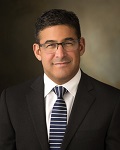 Marc Harrison promised to turn Intermountain into a 'Tesla.' He wasn't kidding.
Marc Harrison promised to turn Intermountain into a 'Tesla.' He wasn't kidding.
Marc Harrison, president and CEO of Intermountain Healthcare, talks about Intermountain's recently announced strategic reorganization, previews the launch of a "virtual hospital" to better serve rural communities, and shares the surprising worry that keeps him up at night. Read our interview with Marc.
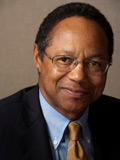 Duke Health CEO's advice for young leaders: Take more risks
Duke Health CEO's advice for young leaders: Take more risks
Dr. Eugene Washington, Chancellor for Health Affairs at Duke University and President and CEO of Duke University Health System, talks about why he sees population health improvement as the system's "ultimate goal," his thoughts on the future of AMCs, and his phone-free approach to unwinding. Read our interview with Eugene.
Don't miss out on the latest Advisory Board insights
Create your free account to access 2 resources each month, including the latest research and webinars.
Want access without creating an account?
You have 2 free members-only resources remaining this month remaining this month.
1 free members-only resources remaining this month
1 free members-only resources remaining this month
You've reached your limit of free monthly insights
Become a member to access all of Advisory Board's resources, events, and experts
Never miss out on the latest innovative health care content tailored to you.
Benefits include:
You've reached your limit of free monthly insights

